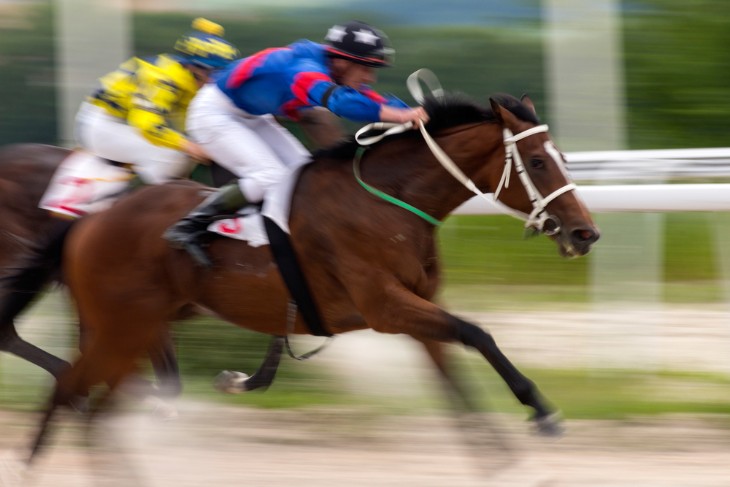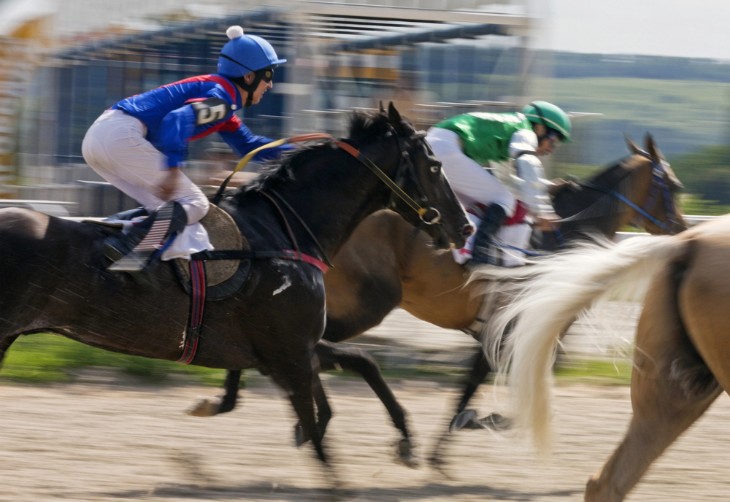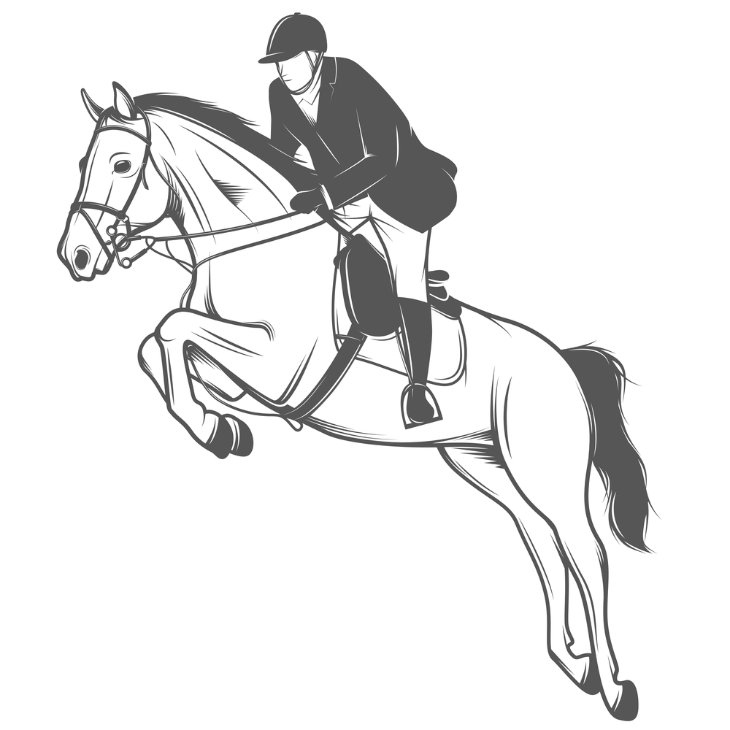Jumps racing, a captivating and time-honoured equestrian pursuit, forms a vital part of the United Kingdom's rich sporting heritage. As hooves thunder over verdant courses, the thrill of watching horses navigate challenging obstacles creates an exhilarating experience for spectators and participants alike. In this comprehensive guide, we delve into the captivating world of jumps racing, exploring its history, nuances, and the factors that make it a distinct and cherished facet of British horse racing.
Jumps Racing in the UK
Imagine the scene: a crisp winter morning, the air tinged with anticipation, as horses and riders assemble on the course. The distinctive sound of pounding hooves and the rhythmic beat of a galloping horse combine with the collective gasp of the crowd as the first obstacle approaches. Welcome to the electrifying world of jumps racing, where sheer athleticism, strategic precision, and heart-stopping moments merge to create an unforgettable spectacle.
Jumps racing, also known as National Hunt racing, involves horses navigating a course featuring hurdles, fences, and other obstacles. This equestrian discipline is a captivating fusion of speed, stamina, and sheer determination. Unlike flat racing, where horses race on level ground, jumps racing presents a unique challenge: negotiating a range of obstacles that test a horse's mettle and a jockey's skill.
The roots of jumps racing in the UK date back centuries, intertwined with the fabric of rural life. It has evolved from the need to prove a horse's ability to traverse challenging terrains, mirroring the historic role of horses in agriculture and transportation. Over time, jumps racing has blossomed into a thrilling sport that captures the hearts of many, drawing enthusiasts to iconic racecourses across the nation.
The Rich History of Jumps Racing
To truly appreciate jumps racing, one must delve into its storied history, replete with tradition and tales of valiant steeds and daring jockeys. The origins of jumps racing can be traced back to the 18th century, when informal races took place across rural landscapes. Horses, often locally bred and renowned for their resilience, were tested for their ability to conquer natural obstacles like hedges and streams.
It wasn't until the 19th century that jumps racing gained formal recognition, with the establishment of the National Hunt Committee in 1866. This marked the beginning of a regulated framework for jumps racing, paving the way for the development of standardized rules and the expansion of the sport.
The Grand National, undoubtedly the crown jewel of jumps racing, emerged in the mid-19th century as a gruelling test of skill and stamina. A true test of horse and rider, this iconic race captures the nation's attention, drawing millions of viewers and demonstrating the enduring appeal of jumps racing.
As the years passed, jumps racing continued to evolve, witnessing advancements in training techniques, horse breeding, and course design. Modern safety measures have been introduced to ensure the welfare of both equine and human athletes, reflecting a commitment to the sport's sustainability and growth.

Key Differences between Jumps and Flat Racing
While both flat racing and jumps racing share a common love for the equine world, they present distinct challenges and characteristics that set them apart. Jumps racing, as we've seen, involves navigating a course adorned with a variety of obstacles that test a horse's agility and a jockey's finesse. In contrast, flat racing focuses on speed, with horses sprinting on a level track without any hurdles or jumps.
The tactical elements of jumps racing come to the forefront as jockeys must carefully time their jumps and manoeuvres to clear obstacles effectively. The ebb and flow of the race can change in an instant as riders make split-second decisions, seeking the optimal path to victory while ensuring the safety of both horse and rider.
Flat racing, on the other hand, hinges on raw speed and stamina. Horses strive to unleash their maximum velocity over a shorter distance, often accompanied by heart-pounding finishes that leave spectators on the edge of their seats. The absence of jumps doesn't diminish the intensity; rather, it places the spotlight on the horses' innate athleticism and the jockeys' ability to coax the best performance from their mounts.
Both disciplines offer their own brand of excitement, attracting dedicated followers who appreciate the diverse talents required for success. As we delve further into the world of jumps racing, we'll uncover the intricacies that make this thrilling equestrian pursuit a cherished favourite among racing aficionados.
Types of Jumps Races: Hurdles, Steeplechases, and Cross-Country
In the enthralling tapestry of jumps racing, various forms of races add depth and diversity to the sport. From hurdling gracefully over obstacles to tackling formidable steeplechase courses, and even venturing into the scenic terrain of cross-country, each race presents its own unique challenges and thrills.
Hurdles races are a testament to agility and precision. As horses approach a series of carefully spaced hurdles, they must time their jumps flawlessly to clear the obstacles without losing momentum. Hurdles races are often seen as an excellent starting point for novice horses, allowing them to develop their jumping skills gradually while showcasing their potential.
Steeplechases, on the other hand, take the excitement to new heights - quite literally. These races introduce formidable fences that demand a blend of power, technique, and bravery. Horses and jockeys must negotiate these solid obstacles, which vary in height and construction, requiring a calculated approach to ensure a successful leap.
Cross-country races offer a departure from the traditional racetrack setting. In these races, horses navigate a course that traverses diverse landscapes, from fields and forests to water elements. The unpredictable nature of cross-country racing underscores the importance of adaptability, as horses and riders encounter an array of natural challenges that test their versatility and resilience.
Whether it's the elegant finesse of hurdling, the daring spectacle of steeplechasing, or the adventurous spirit of cross-country, each race type contributes to the rich tapestry of jumps racing, offering both participants and spectators an array of captivating experiences to savour.
Iconic Jumps Racing Venues across the United Kingdom
The enchantment of jumps racing is intertwined with the storied venues that host these gripping events. From historic racecourses steeped in tradition to modern facilities that embody the spirit of the sport, the United Kingdom boasts an array of iconic venues that have witnessed unforgettable moments in jumps racing history.
Aintree Racecourse stands as a monument to the sport, hosting the renowned Grand National since its inception in 1839. The famous Aintree fences, such as Becher's Brook and The Chair, have become legends in their own right, challenging generations of horses and jockeys to conquer their formidable heights and widths.
Cheltenham Racecourse, nestled in the picturesque Cotswolds, is synonymous with the Cheltenham Festival, an annual extravaganza that showcases the pinnacle of jumps racing. The roar of the crowd as horses thunder up the iconic Cheltenham hill is a hallmark of the festival, while races like the Cheltenham Gold Cup and the Champion Hurdle are revered as some of the most prestigious contests in the jumps racing calendar.
Other notable venues, including Haydock Park, Kempton Park, and Newbury, each contribute their own unique charm to the jumps racing landscape. These venues host races that capture the essence of the sport, drawing enthusiasts and spectators from far and wide to witness the electrifying spectacle of jumps racing in all its glory.
Notable Jumps Racing Horses and Their Achievements
The annals of jumps racing are adorned with the stories of exceptional equine athletes whose feats have left an indelible mark on the sport. From gallant steeds that conquer the Grand National to agile hurdlers that dominate the Cheltenham Festival, these horses capture the imagination and hearts of racing enthusiasts.
Red Rum, affectionately known as "Rummy," stands as one of the most celebrated figures in jumps racing history. With three Grand National victories in the 1970s, Red Rum's unparalleled triumphs over Aintree's daunting fences secured his place as a true racing legend, forever etching his name into the collective memory of the sport.
Kauto Star, a horse of extraordinary talent, reigned supreme in the world of steeplechasing. His five King George VI Chase victories showcased his prowess over fences, while his battles with fellow champion Denman captivated audiences and elevated jumps racing to new heights of excitement.
These luminaries are but a few examples of the remarkable horses that have graced the jumps racing stage. Their achievements serve as testaments to the harmonious partnership between horse and human, the dedication of trainers and jockeys, and the enduring allure of a sport that continues to captivate generations.

Safety Measures and Welfare Concerns in Jumps Racing
In the pursuit of exhilarating sporting spectacles, the safety and well-being of both equine and human participants take precedence. Jumps racing has evolved over the years to incorporate a range of safety measures and protocols that prioritise the welfare of horses and minimise risks for all involved.
Course design plays a pivotal role in ensuring safety. Modern jumps racing courses are meticulously constructed to provide a fair challenge while minimising the potential for injury. Fences and hurdles are designed with safety features that allow them to give way upon impact, reducing the severity of falls and enhancing the chances of a safe outcome.
Regular veterinary care and health monitoring are paramount to the welfare of jumps racing horses. Trained professionals assess the fitness and soundness of horses, intervening when necessary to address any concerns and ensure that only horses in optimal condition compete in races. Rigorous pre-race veterinary checks help identify any potential issues that may affect a horse's ability to race safely.
Jockeys also play a pivotal role in ensuring safety during jumps races. Their training includes techniques for guiding and supporting horses during jumps, contributing to a smoother and safer traversal of obstacles. Jockeys are well-versed in the art of reading a horse's behaviour and adjusting their riding style accordingly, allowing them to respond to the horse's cues and maintain control throughout the race.
The ongoing commitment to safety and welfare reflects the deep respect and appreciation for these magnificent animals. As jumps racing continues to evolve, innovations and advancements will undoubtedly further enhance the protection of both horses and participants, ensuring that this cherished sport remains a showcase of athleticism and horsemanship in the safest possible environment.
The Thrill of Jumps Racing: Spectator Experience and Betting Tips
For spectators, jumps racing offers an immersive and electrifying experience that transcends the boundaries of the racetrack. The atmosphere is charged with excitement as the crowd collectively holds its breath, witnessing the dynamic interplay between horses, jockeys, and obstacles. The sight of horses soaring over jumps or navigating intricate courses is a visual feast that ignites passion and awe.
Attending a jumps racing event is not merely about watching the races; it's about immersing oneself in the vibrant culture that surrounds the sport. From traditional attire to hearty camaraderie, race days are a celebration of British heritage and sporting enthusiasm. The palpable energy of the crowd, the aroma of food stalls, and the flutter of race programmes create a sensory tapestry that heightens the experience.
Betting is an integral part of the jumps racing experience, adding an extra layer of engagement and anticipation. Novices and seasoned punters alike can engage in the thrill of placing wagers on their chosen horses, carefully considering factors such as form, track conditions, and jockey performance. While luck undoubtedly plays a role, informed betting decisions can lead to thrilling victories and an added sense of connection to the races.
As you embark on your own jumps racing journey, remember that it's not just about the races themselves; it's about embracing the culture, revelling in the atmosphere, and marvelling at the incredible athleticism and dedication of horses and humans alike. So, whether you're a passionate racing enthusiast or a curious newcomer, the world of jumps racing invites you to join in the exhilarating spectacle and create lasting memories that celebrate the splendour of this captivating equestrian pursuit.








